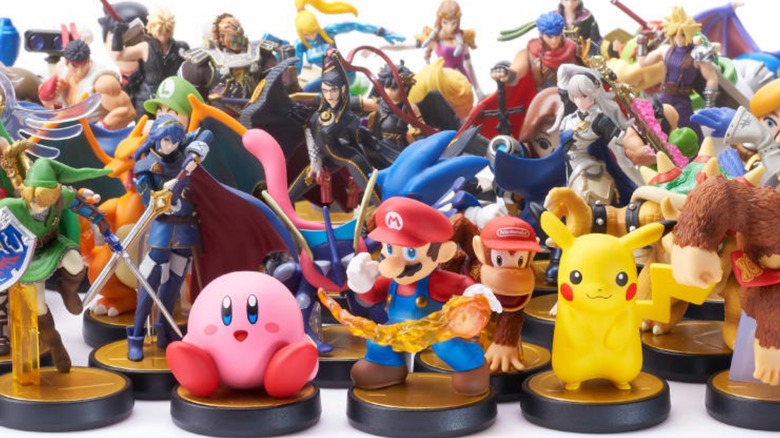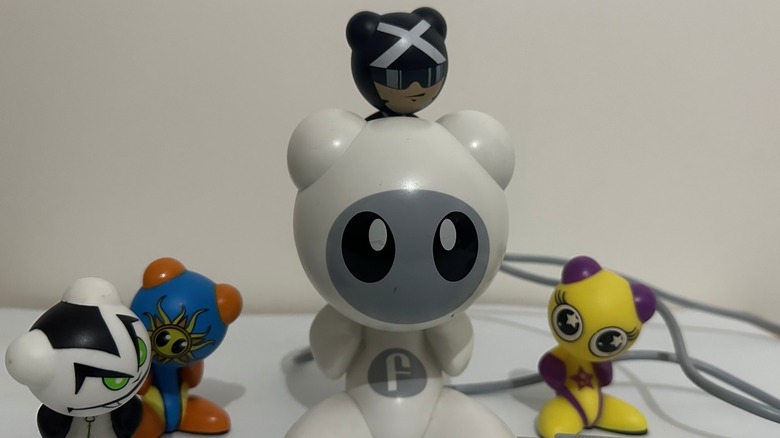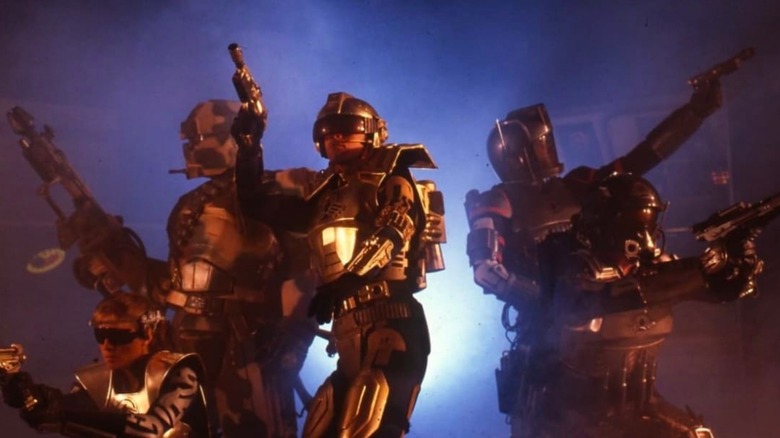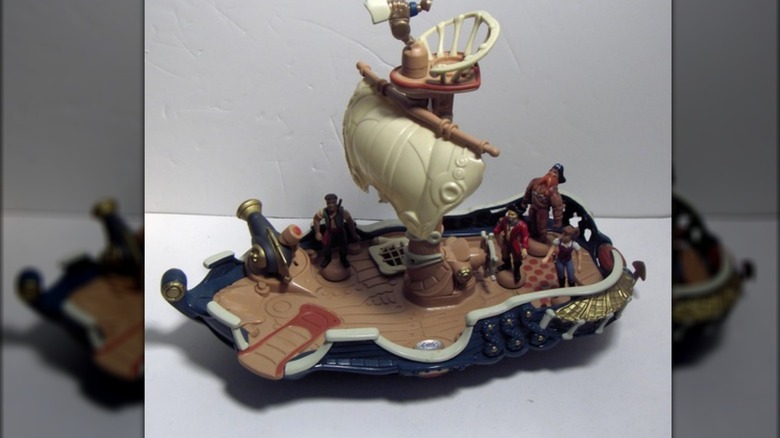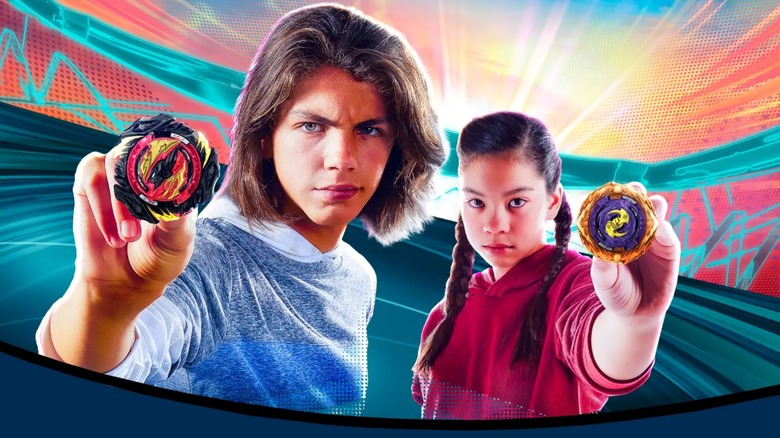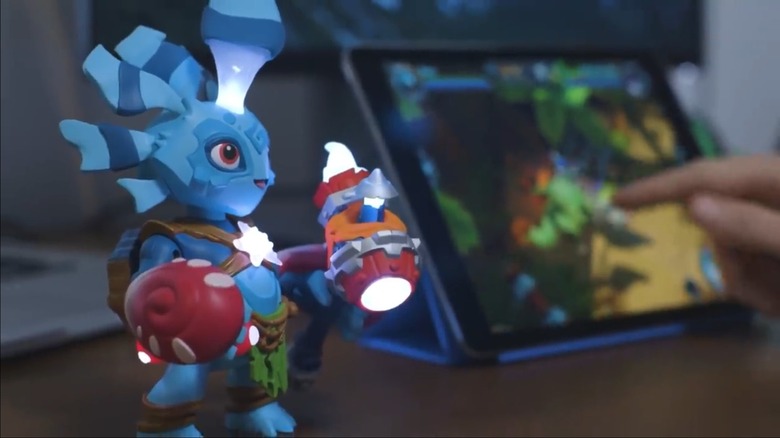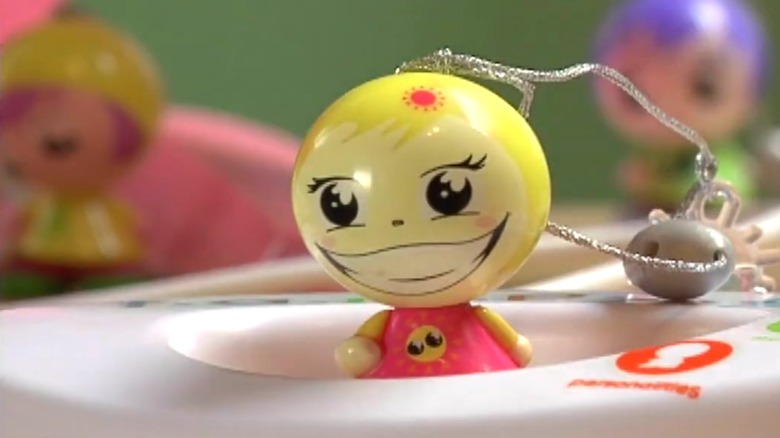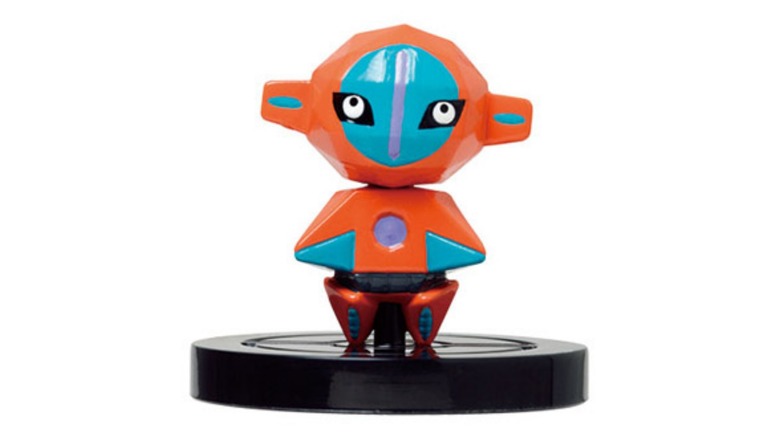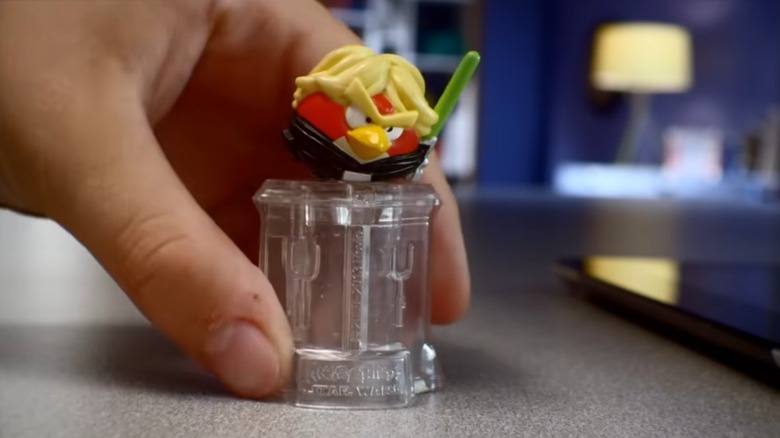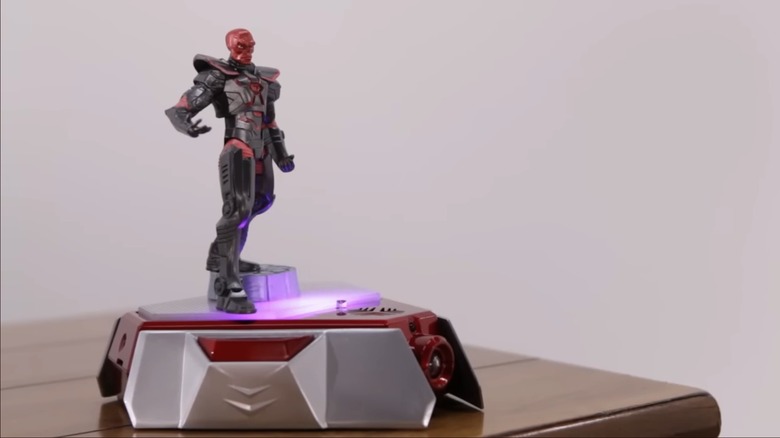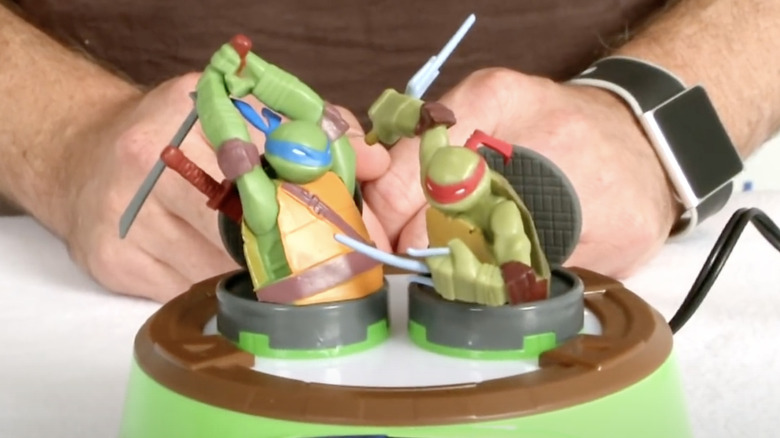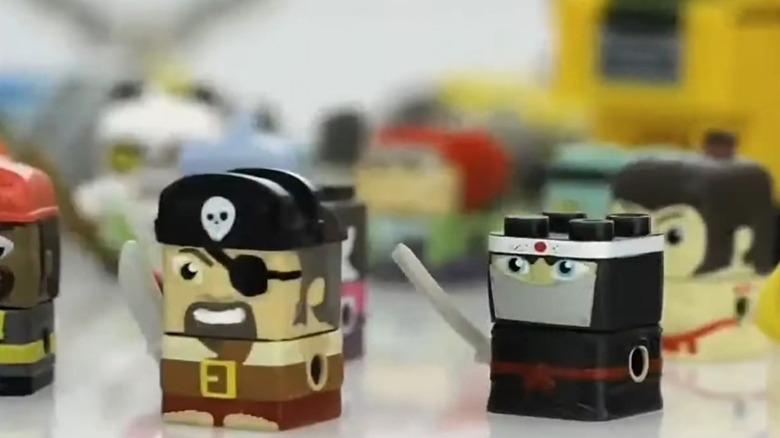11 Obscure Toys-To-Life Products You Probably Didn't Realize Exist
Video game manufacturers are always looking for the next big peripheral. Some are controllers designed for popular platforms like the Xbox and PlayStation, while others are console add-ons (or just plain old consoles) that encourage exercise by constructing workout routines through a gaming lens. One of the latest additions to the gaming peripheral library was the toys-to-life market, although given how many companies still make these products, you could probably call it a fad.
As the name suggests, "toys-to-life" refers to physical figures that doubled as physical DLC. Take for instance, "Lego Dimensions." The game came packaged with several Lego figures that were transported into levels when placed on a device that linked to a console. To unlock optional levels and characters, players could purchase additional packages with even more characters. More than that, every package of "Lego Dimensions" goodness was a fully functioning Lego set users could build and was compatible with other Lego products. "Lego Dimensions" was peak toys-to-life design, a product viable as both a video game add-on and a standalone toy.
While the toys-to-life landscape saw initial success with lines such as "Skylanders" and "Disney Infinity," only Nintendo's amiibo retain any market presence today. However, "Skylanders," "Disney Infinity," Lego Dimensions," and amiibo weren't the only toys-to-life available. The market was so saturated that more than a few lines passed under audience radars. Some toys-to-life were even produced before the peripheral proved itself, and therefore flew under the radar.
Here are some toys-to-life products that you probably never realized once lined store shelves.
U.B. Funkeys
No two people decorate their houses the same way. One somewhat recent ornamentation fad involves collecting figures designed by contemporary artists and constructed out of polyvinyl chloride, also known as vinyl. These "vinyl art toys" come in a variety of shapes and sizes, and they generally sport striking colors and exaggerated designs that cater to younger audiences. Coincidentally, this demographic tends to play video games, so why not combine the markets?
Mattel's U.B. Funkeys is widely considered the first true toys-to-life product. The titular Funkeys were a series of vinyl figures with poseable heads. All Funkeys shared the same body shape but sported a variety of eclectic paint jobs and themes, ranging from sharks and pandas to robots and vinyl records. This design philosophy is not unheard of in the vinyl art toy landscape, as the company Kidrobot uses it for their Dunny and Labbit lines.
To interface with the "U.B. Funkeys" game, figures were placed onto a hub (which looked like a giant plastic Funkey) that connected to a computer via USB. Each figure unlocked a new in-game skin and area to explore, which introduced a huge problem. To see everything in the game, players had to purchase every Funkey. Moreover, each design came in different rarities, which affected their appearances and provided in-game benefits such as exclusive store items.
U.B. Funkeys only lasted three years until Mattel discontinued the line and game. While you can't use Funkeys as physical DLC anymore, they still make for good decorations if you're into vinyl art toys. They would fit right in with your Dunnys, KAWS, and Jankys.
[Featured image by TechnicalNewt via Wikimedia Commons | Cropped and scaled | CC0 1.0 DEED]
Captain Power and the Soldiers of the Future
Toys-to-life figures are generally designed with video games in mind. Each figure unlocks something in a game, and if it uses near-field communication (NFC), the toy can also function as a memory card of sorts. If you're willing to stretch the definition of "toys-to-life," you will find some that predate the technologies commonly associated with video games, especially those that utilize toys-to-life functionality.
"Captain Power and the Soldiers of the Future" was a novel show from the late 1980s that spliced together live-action segments with animated sequences. The result was half "G.I. Joe," half "Battlestar Galactica," all glorified toy commercial. Granted, many shows/cartoons from that era were made to sell toys — just look at "Transformers" and "He-Man." However, "Captain Power" had a unique trick up its sleeve.
The "Captain Power" line of toys consisted of playsets such as sci-fi vehicles and action figures that could ride in them. Each playset included lights and sounds, as well as infrared light emitters and receivers that let them loosely interact with the show. Certain segments fired infrared beams that the toy line's jet fighters and bunker bases could react to as if they were hit by laser tag opponents behind the screen. Likewise, audiences could use the playsets to fire back. Since every episode of "Captain Power" was pre-recorded, the toys couldn't affect the outcome, but viewers could try to hit as many targets as they could. Since the electronics were all in the vehicles and bases, figures were just add-ons; soldiers whose only purpose was to eject from a cockpit if players lost.
"Captain Power and the Soldiers of the Future" only lasted one season, and when the show died, the line of toys died along with it.
RedBeard's Pirate Quest
The term "toys-to-life" is a vague one. Usually, it describes physical add-ons for video games or even games that rely on toys. After all, you can't play "Skylanders," "Lego Dimensions," or "Disney Infinity" without their respective figures. However, these aren't the only definitions. One company tried to make a toys-to-life experience that used an entire playset as a game controller.
Zowie Intertainment's "RedBeard's Pirate Quest" was marketed as "a smart toy playset" that combined a video game with, well, a pirate ship playset. Each copy of the game included a complete ship along with several figures that could slot into different sections of the playset. The ship and figures could be used on their own like any other playset, pirate-themed or otherwise, but the magic truly started when the ship was linked to a Windows 95/98 PC.
Every action and activity in "RedBeard's Pirate Quest" was linked to the pirate ship. Need to fire the cannon at encroaching sea serpents? Twist the plastic cannon on the playset and let loose a volley of vengeance. Sailing through choppy waters? Twist the tiny steering wheel and plot a safe course. While little information about "RedBeard's Pirate Quest" remains, according to the back of the box, the ship and game were capable of recognizing different characters when they were placed onto the miniature toy's deck.
Zowie Intertainment only lasted a scant few years before Lego absorbed the company. Zowie made only one other toys-to-life playset, Ellie's Enchanted Garden, which shared the same "control a video game with a physical playset" design philosophy, but was targeted at girls.
Beyblade Burst
The dirty secret of some toys-to-life products is that they aren't necessary for their video games. Plenty rely on QR codes that players can scan using smart device cameras. This might sound like cheating, but it lets standalone toys also serve as add-ons for video games without compromising performance or durability. Why rely on only plastic figures when you can turn a spinning top into a toys-to-life product?
Beyblade is a fairly popular line of competitive toy tops, especially in Japan, that has been around since 1999. The game has been through several incarnations, but the goal always remained the same: Players mix and match parts to create their ideal tops, then let it rip in a small plastic arena. Video game developers have tried translating the thrill of top-based combat into digital form, one of which relies heavily on the actual product.
"Beyblade Burst" is a mobile app that lets players customize virtual Beyblade tops and go head-to-head against others across the globe. The most reliable way to unlock in-game parts is to purchase respective Beyblade products in real life and scan the QR codes into the app. Plus, the app isn't limited to piecemeal parts. Physical Beyblade launchers and stadiums also include QR codes that unlock cosmetic options for more battlefield variety.
Unlike many toys-to-life games, once someone scans a QR code, the "Beyblade Burst" customization options are theirs to keep. However, you don't even need to purchase any toys to unlock them in the app; plenty of QR chroniclers have assembled libraries of codes you can scan into the app free of charge. This might seem cheap, but if you can't find specific Beyblades at your local store, it might be your only option.
Lightseekers
Many toys-to-life games utilize figures, but they don't utilize action figures — action being the keyword. What's the difference? You can pose action figures, but toys-to-life figures are generally static plastic statuettes, occasionally with NFC electronics inside them. Granted, plenty of normal toys sport electronic features, but these are generally lights and sounds. It took a video game company to figure out how to put NFC hardware into action figures.
PlayFusion's Lightseekers was a short-lived series of figures designed in conjunction with a mobile dungeon crawler RPG, "Lightseekers Awakening." The goal was novel as far as toys-to-life went: Poseable action figures that could link to a video game and serve as both memory cards and controllers. We're talking seven inches tall, multiple joints, colorful paint jobs, lights and sounds, and optional weapons (each sold separately).
The magic behind Lightseekers was the "FusionCore." This removable device can be plugged into the back of each figure and can differentiate between characters and accessories. Slotting the FusionCore into figures unlocked them in the game, and swapping weapons was handled by inserting them into the toy's hands. This tech ran on the same premise as Ubisoft's "Starlink: Battle For Atlas" toys-to-life game while also predating it.
Unfortunately, the Lightseekers line didn't last long. PlayFusion only produced four figures and 14 accessories (eight weapons, two shields, and four jetpacks) before canceling future plans. The company also produced a series of physical trading cards, many of which could produce augmented reality effects, as well as a digital version of that game.
On the bright side, the failure of Lightseekers didn't hit PlayFusion too hard. The company is still making video games, albeit ones that don't ask players to buy action figures.
F.A.M.P.S
It is not uncommon for designers recycle ideas. For example, Spin Master's Bakugan are spring-powered marbles that flip open when they roll over magnetic cards, and when the company tried to capture the same gimmick for girls toys, they came up with Zoobles. While Zoobles retained the springs and magnets, they abandoned all competitive game mechanics. Mattel tried a similar tactic with their toys-to-life lines.
F.A.M.P.S (short for Feelings, Attitudes, Moods, Personalities) was a line of plastic keychains aimed at girls. Like their Funkey counterparts, every F.A.M.P.S. sported bright and striking colors with oversized heads. Moreover, F.A.M.P.S. could serve as physical decorations, but instead of lining shelves as palm-sized art pieces, they were meant to adorn backpacks, purses, and lanyards. However, they also acted as physical DLC for a computer game.
Technically calling the program that relied on F.A.M.P.S figures a "game" is a misnomer; it was actually a desktop customization suite. Users could alter how their computer's main screen looked, send special emails stamped with F.A.M.P.S girls faces, and play minigames. Each figure, when inserted into the F.A.M.P.S portal, unlocked a different theme with accompanying options and games. This sounds like a downgrade compared to the full-fledged game U.B. Funkeys hobbyists received, however, F.A.M.P.S collections were much easier to complete. Mattel only released 12 figure styles, none of which were divided into different rarities.
Like the U.B. Funkeys before them, F.A.M.P.S only lasted a few years before the toy line and support for its program were discontinued.
Pokémon Rumble U
Nintendo's amiibo are probably the most famous toys-to-life products available, partially because they are the only toys-to-life products currently being produced. Moreover, unlike other toys-to-life figures, amiibo are compatible with multiple games. While Nintendo certainly hit it out of the park with their amiibo, the company used one of its most prosperous properties as a precursor prototype.
"Pokémon Rumble U" was the third entry in the "Pokémon Rumble" series and released on the Nintendo Wii U. From a gameplay standpoint, "Rumble U" was an arena-based brawler where heavily stylized and polygonal Pokémon bumped into one another to attack, and players could grow their teams by catching many of the Pokémon they beat senseless. Alternatively, players could scan a "Pokémon Rumble U" figure.
The toys Nintendo released for "Pokémon Rumble U" were the company's first NFC-enabled figures, which makes them the predecessors of amiibo. Each "Pokémon Rumble U" copied the game's polygonal art style and unlocked their respective Pokémon – the Genesect figure unlocked Genesect, the Deoxys figure unlocked Deoxys, and so on. Moreover, since the figures used NFC technology, players could customize their Pokémon, save the creatures to the figure, and share them with friends whenever they played "Pokémon Rumble U" together.
Since the Nintendo 3DS and Wii U eShops went dark in March of 2023, you can't play "Pokémon Rumble U" anymore. Plus, Nintendo discontinued the figures long before that. Even if you can find one in the aftermarket wilds, it's dubious their NFC technology will work with any modern Nintendo games, so don't expect the Pikachu figure to work like a standard Pikachu amiibo.
Angry Birds Telepods
You'd be hard pressed to find a person who hasn't heard of "Angry Birds." The IP has hatched numerous video games, movies, and toys that brought the bird-flinging action into the real world. As the series grew, the developers at Rovio tried combining the digital and physical games and created "Angry Birds" projectiles usable in both mediums.
Several "Angry Birds" toy lines revolved around what were known as Angry Birds Telepods. Take the standard "Angry Birds" playset that let children build their own pig fortresses and fling birds at them. Those were just normal plastic projectiles, but when companies designed physical toys based on the "Angry Birds Go!," "Angry Birds Stella," "Angry Birds Transformers," and "Angry Birds Star Wars II" spin-offs, they stuck QR codes on the bottom of each plastic character. This addition let players use the figures, dubbed "Telepods," in the real world and in smartphone apps.
Each set of Telepods included a plastic stand that magnified the codes so "Angry Birds" apps could recognize them. When scanned, Telepods either provided temporary boosts or unlocked characters, depending on the "Angry Birds" game. For instance, while playing "Angry Birds Star Wars II," someone could scan a General Grievous pig figure and receive a one-use General Grievous projectile to fling across the screen and wreak Separatist-styled havoc. Alternatively, they could use the figure as slingshot ammo for their "Angry Birds Star Wars" set.
While every Telepod included a different QR code, compatibility was locked to their respective games. As cool as it might sound, you couldn't mix and match the Boba Fett pig with "Angry Birds Transformers." Then again, according to user reports, Telepod functionality has been patched out of all "Angry Birds" games.
Playmation
Kids don't have to use their imaginations quite so much these days. Why pretend a long cardboard tube is a sword when you can play a "Legend of Zelda" game? Why hold a television remote like a laser gun when you can buy a Nerf blaster? Sure, plenty of children use their imaginations when playing with action figures and dolls, but leave it to Hasbro and Disney to try and channel that imagination with a toys-to-life product.
Playmation was a line of interactive toys that encouraged children to get up and move. The system used a combination of smart devices and hubs that ran on toys-to-life figures. The Avengers-themed starter set included one hub, two figures, and an Iron Man repulsor blaster replica. Missions were more or less one-man games of laser tag, usually against the hub. However, it fired back, forcing players to stay on the move and occasionally take cover.
While the Playmation starter set included quite a few missions, children could expand their options by purchasing additional accessories, weapons, and figures. Each starter set included Captain America and the Red Skull, and Hasbro also sold characters like Iron Man, Ultron, Hulk and Falcon for even more laser tag allies and opponents. Unlike other toys-to-life products, Playmation wasn't designed for video games; all the action took place in the player's living room and imagination. However, Hasbro did provide an accompanying app to help players keep track of mission progress and unlocks.
Hasbro and Disney had big plans for Playmation, as the companies wanted to follow up the Avengers line of figures and accessories with "Frozen" and "Star Wars" versions. Unfortunately, lackluster sales made the companies axe those plans and layoff much of the team behind Playmation.
Hero Portal
Plug-and-play devices are the bane of many gamers. Your video game-illiterate grandparents can't find a copy of "Spongebob Squarepants: Battle for Bikini Bottom Rehydrated" for the Xbox, so they buy you a JAKKS Pacific "Spongebob Squarepants" plug 'n play device instead. Same thing, right? Not even close, and to be more confusing, the company also released several toys-to-life plug 'n plays.
Hero Portal was JAKKS Pacific's only entry into the toys-to-life business. Each device consisted of a controller connected to the titular portal, which plugged directly into a TV, like a copy of "Skylanders" that didn't require an Xbox or PlayStation. Hero Portal also mimicked how figures function in "Skylanders." To control any character, players had to plop a proprietary toy onto the portal. However, instead of creating an original IP, JAKKS Pacific played to its strengths and relied on licensed properties.
Four Hero Portal versions were produced, based on DC Superheroes, "Teenage Mutant Ninja Turtles," "How to Train Your Dragon," and "Power Rangers Megaforce." Regardless of IP, each Hero Portal used the same plastic shells and casings, albeit with different colors. Moreover, figures were restricted to their own properties, so even though the Teenage Mutant Ninja Turtles have crossed paths with DC's finest and the Power Rangers, you can't relive these team-ups with a Hero Portal. It didn't help that, like many plug-and-play consoles, Hero Portals gameplay was bare bones across the board.
Nowadays, JAKKS Pacific sticks mostly to plain old figures. The company produces toys based on many of your favorite video game characters, but it doesn't manufacture video games that require toys anymore.
Sick Bricks
As previously mentioned, "Lego Dimensions" was one of the big four toys-to-life lines. Each set included buildable minifigs and vehicles, and the game covered a wide range of proprietary and licensed properties, some of which have yet to crop up as standalone sets. Many companies copy the Lego formula and produce their own block-based building sets, but only one made an accompanying toys-to-life game.
Spin Master's Sick Bricks was an obscure line of building block toys. While Lego focuses on large sets that let customers build vehicles, houses, and landscapes, and then populate them with minifigs, Sick Bricks' priorities were reversed. Sick Brick packs focused on characters who were little more than stacks of 2x2 bricks with faces and clothes painted on, with the occasional monster or vehicle. Every kit was small because they were built around the "Sick Bricks" app; standalone play was secondary.
The "Sick Bricks" game was a dungeon crawler, and most unlockables were tied to a smart device's camera. This app could scan the Sick Brick line's countless characters and vehicles and port them into the game. Since Sick Bricks toys were just bestudded pieces of plastic, all progression and abilities were tracked on the app. Once a character or vehicle was unlocked, the relevant toy could be left to decorate shelves or collect dust.
In November of 2020, Spin Masters shut down the "Sick Bricks" game. Nobody can download it anymore, and anyone who still has it on their smart device can't play it either. On the bright side, you can now buy SIck Brick toys for pennies on the dollar.
